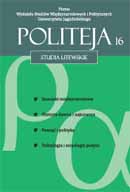Administracja publiczna na Litwie: między postkomunizmem i europeizacją
Public administration in Lithuania: between post-communism and Europeanization
Author(s): Saulius PivorasSubject(s): Politics / Political Sciences
Published by: KSIĘGARNIA AKADEMICKA Sp. z o.o.
Summary/Abstract: The contemporary public administration system in Lithuania was created and developed from scratch after the collapse of the communist administrative system. The EU made an especially big impact during the accession process and later. But Lithuania experimented and merged American, Canadian or Hong Kong models with the European standards in its own system of public administration. One of the most peculiar features of public administration in Lithuania is its clearly legalistic dominance. The legalistic culture and legalistic administrative tradition have their ties to the Soviet legacy as well as to the EU, conditionally. The legalistic vector of Lithuanian public administration has its positive and negative sides. On the positive side there is the assurance (at least at a procedural level) of the supremacy of law. However as this is a traditional model of public administration, it brings with it a lack of economic or managerial efficiency. But Lithuanian-specific, traditional model of public administration means also legal formalism, which is an impediment for flexible and open government, and for more trust in society for state institutions. Civil service reform gained momentum in Lithuania during the EU accession process. Professionalism and depoliticization were the main aspects of the reform, which created a civil service system based on classical Weberian principles. But civil service also developed the characteristic of being a rather closed social group, and in general is distrusted in society as a “bureaucracy”. Management of civil service human resources is in fact very centralized. Lithuania is the only country within Central and Eastern Europe that has a socalled integrated civil service, where the management of human resources in central and local government is based on uniform and rather detailed legal regulations by the parliament and the government.
Journal: Politeja - Pismo Wydziału Studiów Międzynarodowych i Politycznych Uniwersytetu Jagiellońskiego
- Issue Year: 8/2011
- Issue No: 16
- Page Range: ¸383-403
- Page Count: 21
- Language: Polish

